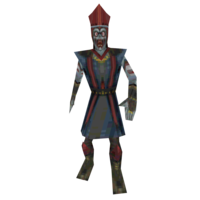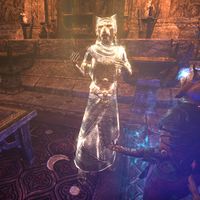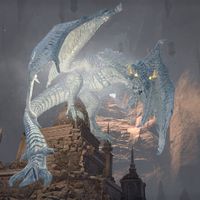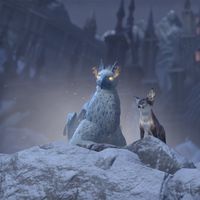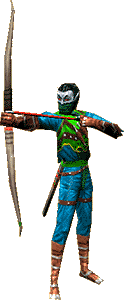Lore:Reincarnation
Reincarnation is a metaphysical concept that occurs when an individual is born with the soul of a prior individual or entity. Many religions in Tamriel profess belief in the concept.[1] Reincarnation can lead to apotheosis if one happens to be reborn as an individual who was some form of deity.[UOL 1] Some believe that reincarnation is not carried out at birth, but rather exists as an achievable spiritual state.[2][3]
Reincarnation Variations[edit]
Reincarnation as Twin Souls[edit]
There have been cases where the spirit of a dead mortal has entered the body of a living being and integrated itself with the living soul residing there. Though ghosts have the ability to possess and animate both living and dead bodies as well as inanimate objects by entering them,[4][5][6][7][8] such phenomena are said to not be the same thing as this spiritual integration. Whereas in a possession the soul of the spirit remains distinct and either exerts direct control over the host body or influences the host's thoughts and emotions, with the host soul sometimes being expelled or having its identity erased outright,[9][10][11] the integration phenomenon results instead in the soul of the spirit merging with the soul of the living host without exerting control, thus the spirit is effectively reborn or reincarnated into the living host, who will than start to experience the memories of that spirit as if they'd lived through them, and manifesting the knowledge and abilities the soul reincarnated within them possessed and feeling its emotions as their own. The phenomenon has also been described as a spirit being resurrected as the "twin soul" of its host. The initial entry of the soul into the living body is accompanied by a brief bout of intense pain, after the rebirth, other spirits who knew the reincarnated soul in life can sense its presence within its reincarnated form and realize the host soul and the reincarnated soul as now being the same. Though such spiritual rebirth is possible, it is said that it is relatively rare for spirits to behave in that manner.[12][13][14][15]
Ascended Ancestors[edit]
Some sources claim that mortal spirits experience a change upon reaching Aetherius, with many souls of mortals becoming spirits of a different sort in that place.[16] Many reports from across Tamriel describe a phenomenon where the souls of the dead adopt a variety of forms to return and speak with the living. Animals, plants, or even fearsome visions, are all reported manifestations. It is theorized that the Luminaries, immortal beings of pure magic, might have originated as mortal souls, being the spirits of Ascended Ancestors that transformed into their current state after death due to this described phenomenon. As the Luminaries themselves can't recall their origins, this theory remains unproven.[17][18] Whatever the case, however, a Luminary can indeed be created out of the essence of a mortal soul, as was the case with the Crow Luminary, who was created through a ritual devised by Ulfsild the Evergreen out of a portion of her own essence. Though the process is straining and the restoration of the spirit takes time, a soul that was used in such a manner will eventually recover.[19][20][21]
Resurrection of Lingering Spirits[edit]
The deeds of a spirit in life can sometimes cloud their path to the afterlife. Such spirits, held back by guilt and unresolved affairs, might refuse entry into the afterlife even if they have been accepted into it, holding themselves back as long as their unresolved affairs remain. In some cases these powerful unresolved emotions might even cause the soul itself to crack and be wounded, allowing for a Void to be created within it. While being summoned to provide aid to the living via lending their strength or inhabiting and animating bodies willingly through redemptive necromancy such as that employed by the Order of the Hidden Moon can help spirits resolve their issues and move on to the afterlife, there have been cases where, through the intercession of a deity, such lingering spirits have been reborn into the world instead. Spirits reborn in this manner have their soul returned to their resurrected bodies, exhibiting only fragmentary memories of their time in the afterlife. The act of rebirth can fill the being of these revived individuals with Soulfire, which in the case of spirits resurrected from Azurah's Crossing makes their eyes burn bright blue, a phenomenon also said to occur with those who visit Moonshadow.[22][23] Forgiving one's self can heal the Void-wound, allowing that spirit to proceed to the afterlife beyond. At the point at which this is achieved the resurrected soul will sense it, giving them the option to return to the afterlife or to remain in the living world to live out their second life. Khajiit call this type of rebirth a "Second Pounce" and consider it a not entirely dissimiliar but nonetheless distinct form of rebirth to that of reincarnating as the Twin Soul of one of the living.[24] The Daedric Prince Azurah has been known to resurrect certain souls in her care in this manner.[13][14][12][25]
Culture[edit]
Argonian[edit]
Argonian souls return to the Hist after death.[26] From here, the Argonian soul travels down the river called Rebirth.[27][28] In some cases, particularly old and wise souls can help lead other souls through the cycle.[29]
Argonians hold the belief that those of other races are also reincarnated.[30]
Breton[edit]
Druids believe in a natural cycle of death and rebirth,[31] for Y'ffre blesses the living with the same breath that flows across the world, and it is seen as a blessing for him to withdraw that breath. To die means that one once lived, and at the end there are always new beginnings.[31] Indeed, druids believe in reincarnation. Dovah-flies are such an example; they're believed to be their ancestors given new life.[32]
Dunmer[edit]
Reincarnation as a concept plays a fundamental role in Dunmer theology. It is taught that the Tribunal of living gods, Vivec, Almalexia, and Sotha Sil are reincarnations of their predecessors the Anticipations.[33]
Upon the death of Indoril Nerevar, the Chimer Hortator, sources claim that the Daedric Prince Azura vowed that Nerevar would come back to set things right.[34][35] This led to prophecies and cults forming over an individual known as the Nerevarine who would be Nerevar reborn and make good on Azura's word.[36] Many individuals claimed to be this figure of prophecy, but all turned out to be False Incarnates until one arose in 3E 427 meeting all the criteria. This figure would go on to defeat the feared enemy of the Dunmer, Dagoth Ur.[37]
The Dunmer assassin Dram, through means not fully known, was a thrice-born individual having two prior incarnations before his confrontation with Cyrus.[38]
Ice Tribes[edit]
Little is known about the beliefs of the Ice Tribes. The most powerful warriors among them are known as Thriceborn, and the tribes are also known to have utilized a powerful beast known as the Gehenoth Thriceborn.[39] However, it is unknown if either of these examples are literal instances of reincarnation.
Imperial[edit]
The Saint of the Imperial Church Pelinal Whitestrake was strongly associated with the concept of reincarnation.[40][41] It is speculated that him being a thrice incarnated individual is possibly why he held the epithet Pelinal the Third.[40] He was best known under his common name Pelinal, along with other identities in Hans the Fox and Harrald Hairy Breeks.[42]
As he was dying from wounds received in battle with Umaril the Unfeathered, his nephew Morihaus predicted that Pelinal would come again.[43] This prognostication proved accurate, as the Hero of Kvatch eventually proved to be an embodiment of Pelinal Whitestrake, the Divine Crusader reborn.[44] The Hero of Kvatch would finish what Pelinal did not and destroy Umaril utterly.[45]
Khajiit[edit]
The Khajiit believe that their souls fill many vessels and take many forms before the end.[46] Their tradition holds that there is only one Mane spiritual leader alive at any time, and that each Mane is simply one individual spirit reborn into different bodies.[47]
One Khajiit account describes how a Khajiit soul travels to Azurah's Crossing after death, and encounters Azurah herself. At that point the spirit remembers that it has lived and experienced the passage to the afterlife many times, and mentions it to Azurah. To this observation Azurah responds that the spirit has "walked many paths" to stand before her.[48]
Reachfolk[edit]
One of the Reachfolk clans was known for their belief that messages from their ancestors were conveyed through Powderwhite Coneys. Certain sources even considered these animals to be these ancestral figures in their own right.[49] Cicada husks represent rebirth to the Crow-Eye Clan.[50][51]
Redguard[edit]
While numerous Tamrielic cultures hold beliefs in various forms of reincarnation, Redguard adherents of Satakal hold to the cyclical nature of the world, envisioning the reincarnation of the world itself.[1]
Skaal[edit]
The Skaal hold the belief that when a living being passes away, its spirit is reunited with the All-Maker, who subsequently reshapes it into a fresh entity and reintroduces it into the material realm to embark on a new existence in a different form. Consequently, the Skaal perceive death differently from other Nords. They regard all life as sacred and strive to coexist harmoniously with nature, minimizing their impact on the environment whenever feasible.[52][53]
References[edit]
- ^ a b Coil of Satakal antiquity codex entry
- ^ Decoded package — Glabrio Bellienus
- ^ Nibani Maesa's dialogue in Morrowind
- ^ Janne Emarie's spirit in ESO
- ^ Galgalah's spirit in ESO
- ^ Uldor's spirit in ESO
- ^ Ghost's dialogue in Wilding Run in ESO
- ^ Ghoragham's encounter in ESO
- ^ Farwen Temolire's dialogue in ESO
- ^ Ashu-awa's dialogue in ESO
- ^ Spirit Hunter Mayrineh's dialogue and encounter in ESO
- ^ a b Zerith-var's dialogue in ESO
- ^ a b Cantor Krin'ze's dialogue in ESO
- ^ a b Viti's Notes: Order of the Hidden Moon, Part I — High Cantor Viti
- ^ Krin'ze's Journal — Cantor Krin'ze
- ^ Girnalin's dialogue in ESO
- ^ Loremaster's Archive - Scribing — Votary Nahila
- ^ Ulfsild's Notes: The Origin of Luminaries — Ulfsild
- ^ The Crow's dialogue in ESO
- ^ Ulfsild the Evergreen's dialogue in ESO
- ^ Fable of the Crow
- ^ Krin'ze's Journal — Cantor Krin'ze
- ^ Azure Eyes description in ESO
- ^ Ravith's dialogue in ESO
- ^ Living Death necromancer abilities ESO
- ^ Tree-Minder Deyapa's dialogue during The Tree-Minder's Fate in ESO
- ^ Xukas' dialogue in ESO: Murkmire
- ^ Jaxsik-Orrn's dialogue in ESO: Murkmire
- ^ Sap-Speaker Kuzei's dialogue in ESO: Murkmire
- ^ Scouts-Many-Marshes' dialogue in Skyrim
- ^ a b Druid Funerals: A Piece of Y'ffre — Alleneth of Elden Root
- ^ Glimmergreen Dovah-Fly pet description in ESO
- ^ Songs of Vvardenfell
- ^ Nerevar at Red Mountain — the Tribunal Temple
- ^ The Battle of Red Mountain — Vivec
- ^ Nerevarine cult notes — Sharn gra-Muzgob
- ^ Events of The Citadels of the Sixth House in Morrowind
- ^ Dram Character Biography - Redguard.com
- ^ Thriceborn Warriors and the Gehenoth Thriceborn in Dawnstar
- ^ a b The Song of Pelinal, v 1
- ^ Captain Kaleen's dialogue in ESO: Ascending Tide
- ^ Before the Ages of Man — Aicantar of Shimerene
- ^ The Adabal-a — Morihaus
- ^ The Prophet's dialogue in Oblivion
- ^ Events of Umaril the Unfeathered in Oblivion: Knights of the Nine
- ^ All Our Perfect Forms — Amun-dro, the Silent Priest
- ^ Pocket Guide to the Empire, 1st Edition: The Elsweyr Confederacy — Imperial Geographical Society, 2E 864
- ^ Azurah's Crossing — Amun-dro, the Silent Priest
- ^ Powderwhite Coney's description in ESO
- ^ Shaman Ulvoch's dialogue in ESO: Markarth
- ^ Cicada Husk's description in ESO
- ^ Children of the All-Maker — Tharstan of Solitude
- ^ Lord of Souls — Greg Keyes
Note: The following references are considered to be unofficial sources. They are included to round off this article and may not be authoritative or conclusive.
| ||||||||||||||||||||||
